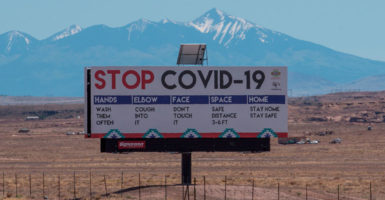The American people must be able to trust the accuracy of public health information disseminated by the federal government, especially during the coronavirus pandemic.
That’s why a reported change by the Centers for Disease Control and Prevention of its guidance on COVID-19 for employers regarding commuters is very disturbing.
In its original guidance issued last week, the CDC recommended that for commuters using public transportation or ride-booking services, employers should consider “[offering] employees incentives to use forms of transportation that minimize close contact with others, such as offering reimbursement for parking for commuting to work alone or single-occupancy rides.”
>>> When can America reopen? The National Coronavirus Recovery Commission, a project of The Heritage Foundation, is gathering America’s top thinkers together to figure that out. Learn more here.
The original guidance also included recommendations for employers on how to assist all commuting employees, regardless of whether those employees can drive.
However, the advice about driving, parking, and single-occupancy rides infuriated environmental organizations and transit special interests. So, they let their feelings be known to the CDC.
Apparently in response, the Centers for Disease Control and Prevention changed the language to say: “If feasible, offer employees incentives to use forms of transportation that minimize close contact with others (e.g., biking, walking, driving or riding by car either alone or with household members).”
The CDC also added a recommendation for employers to ask employees to follow the agency’s guidance on how to protect themselves when using transportation. (This latter guidance provides information on what to do when using several modes of transportation, including public transit.)
So the CDC added the qualifier “if feasible” to the original guidance, took out the recommendation on parking, and added biking, walking, and driving with household members.
It also added a recommendation suggesting that the agency is less concerned with public transit than was conveyed in the original guidance.
Politics and ideology shouldn’t interfere with the government’s best COVID-19 guidance, but it clearly did in this case.
Some of the changes arguably still might be consistent with the original guidance to minimize close contacts, but there’s no way to know whether those changes are a product of the best public health information or a product of succumbing to political pressure.
Inserting the “if feasible” language, removing language related to parking, and adding language to suggest less concern with public transit is inconsistent with the original guidance that showed a preference for driving alone.
This conflating of science, policy, and ideology is nothing new.
For example, environmental activists have been trying to use concerns about climate change and sustainability as a way to change the government’s Dietary Guidelines for Americans. So, instead of federal nutrition policy being based on human health alone, environmental activists want dietary advice to be based on their environmental agenda.
The influential advisory committee that provided recommendations to the government in developing the 2015 Dietary Guidelines did in fact consider those environmental interests. The committee formed a subcommittee that covered “food sustainability.”
In a presentation, the subcommittee explained, “The goal is to develop dietary guidance that supports human health and the health of the planet over time.”
When the federal government released the 2015 Dietary Guidelines, it said environmental considerations didn’t inform the document. Unfortunately, there’s no way to know whether that’s true.
What we do know is that the government allowed its dietary advisory committee to veer way off its mission. Fortunately, the 2020 guidelines process doesn’t appear to have that same problem.
The extreme effort by some to push their environmental ideology, wherever and however they can, may help to explain some other recent developments as well.
For example, the Environmental Protection Agency has been taking commendable steps to try to ensure that environmental regulations are based on science that is transparent and can be properly evaluated.
That’s a bipartisan objective. A 2009 memo issued by President Barack Obama argued: “To the extent permitted by law, there should be transparency in the preparation, identification, and use of scientific and technological information in policymaking.”
Yet, some critics are fighting this commonsense EPA effort to promote transparency. As they claim to care about the science, such actions suggest they care only about ensuring they are allowed to use whatever “science” helps them accomplish their environmental agenda.
Public health information and other federally disseminated scientific information—from the CDC to the EPA—must be separated from ideology and be based on science that can be properly evaluated. That’s the only way to ensure accurate information, and information that’s deserving of the public’s trust.



























